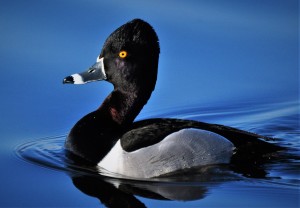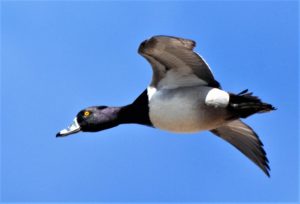Photography courtesy of Lowell Washburn, all rights reserved.
I heard the ducks seconds before I actually saw them. Arriving from behind, the descending flock’s set wings was neatly dividing the firmament into halves, resulting in that unique, jet engine roar that thrills waterfowl enthusiasts to their very core. Rocketing over and past the blind, the half dozen ring-necks – five drakes and a hen — executed an abrupt U-turn and were soon splashing down in front of the hide. Once they’d settled to the water, the ambitious drakes lost no time in competing for the attentions of an apparently indifferent hen.
Whether they’re on the water; on the wing; or on the dinner table – ring-necked ducks are one of my favorite migratory birds. Spending time with these beautifully unique web-foots is synonymous with having a good time. Today has been no exception. I’ve been enjoying over-the-top ring-neck fun and plenty of it.
The morning’s excitement began almost the moment I arrived at a wetland I call the Smartweed Pond. The first incoming ring-necks started to appear while I was still in the process of tossing out decoys. Once my plastic counterfeits were finally in place, I enjoyed nearly two hours of nonstop action as a seemingly endless supply of ducks poured from the sky. The spring ring-neck migration had clearly reached its peak and there would never be a better day to observe this incredible bird in such wholesale numbers. By the time the morning ended, hundreds of ring-necked ducks would have landed in or buzzed my decoys. As happens every once in a while; I had found myself in the right place at the right time. It was an amazing show.
Ring-necked ducks are members of the diving duck clan, which means they have compact bodies, rapid wing beats, and outsized webs. Like other divers, ring-necks obtain most of their food by plunging below the water’s surface. That’s pretty much where most of the similarities with their big water, deep diving cousins end. Although ring-necked ducks have been known to reach bottom in depths exceeding 40 feet, they generally prefer shallower wetlands – especially when those wetlands are loaded with food. And while my less than waist deep, two-acre Smartweed Pond was merely a drop in the bucket by normal diver standards, the reason for its popularity was no mystery. The tiny wetland’s murky bottom was layered in tons of leftover seed from last summer’s bumper crops of smartweed and biden. For ring-necks currently arriving from wintering areas in Louisiana, Mexico, or the Caribbean, this North Iowa wetland was providing a critical rest stop – a welcoming oasis where wing weary migrants could rest and refuel.
But for traveling ring-necks, the stay would be brief. Once the annual flight begins, flocks are hesitant to linger in any one spot for very long. The spring migration trail is lengthy and rigorous. For most pairs, the ancient journey will lead to the remote boreal forests of northern Canada. Here, at the edge of an amber tinged muskeg bog, the ring-necked hen will finally make her nest.






 Tom Cope
Tom Cope Sue Wilkinson
Sue Wilkinson Susan Judkins Josten
Susan Judkins Josten Rudi Roeslein
Rudi Roeslein Elyssa McFarland
Elyssa McFarland Mark Langgin
Mark Langgin Adam Janke
Adam Janke Joe Henry
Joe Henry Kristin Ashenbrenner
Kristin Ashenbrenner Joe Wilkinson
Joe Wilkinson Dr. Tammy Mildenstein
Dr. Tammy Mildenstein Sean McMahon
Sean McMahon